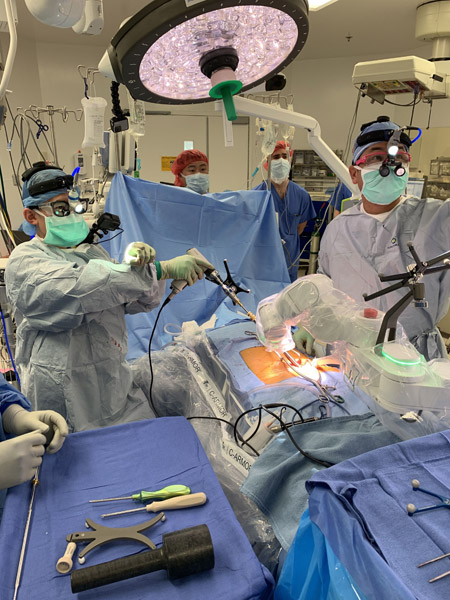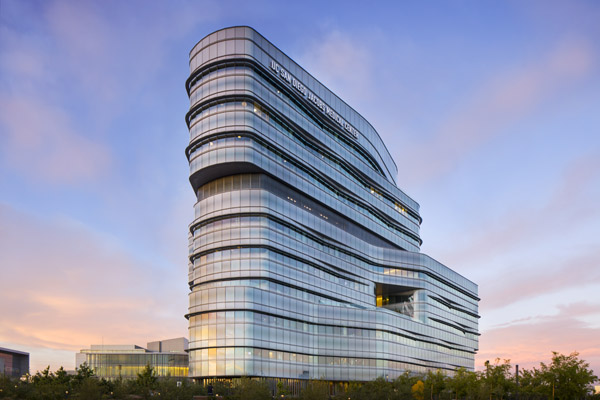Robotic Spine Surgery Program Expands at UC San Diego Health
New technology enables surgical planning and implants in 3D
Published Date
By:
- Jackie Carr
Share This:
Article Content
The human spine is comprised of 24 bones. It provides the body with shape, form and functionality, housing the variegated nerves that communicate continuously between brain and body, transmitting motor, sensory and autonomic signals.
When performing surgery in the spine, precision is everything — the difference between pain and no pain, paralysis and movement. The need for absolute precision is why UC San Diego Health has invested in a new robotic technology to benefit patients in need of restorative spine surgery.

UC San Diego Health has invested in a new robotic technology to benefit patients in need of restorative spine surgery. This robotic-assisted technology enables minimally invasive spine surgery and may shorten operations, reduce the size of incisions and reduce blood loss.
“This robotic-assisted technology enables minimally invasive spine surgery, which has many benefits, including the potential for a shorter operation, less anesthesia, smaller incisions and reduced blood loss, all of which may lead to better outcomes,” said Martin Pham, MD, neurosurgeon at UC San Diego Health. “For patients who have complex spine deformities, such as a large scoliotic curve or invasive tumor growth, this technology helps us map out a difficult procedure before the patient even arrives in the operating room for the first incision.”
Approved by the FDA in late 2018, the Mazor X Stealth Edition System combines three-dimensional surgical planning, robotic guidance and intraoperative navigation. The system allows spine surgeons to pre-plan complex surgical procedures, deploy a robotic arm to guide implant placement and simultaneously deploy real-time imaging feedback to ensure the surgical plan is being carried out correctly and precisely.
Pham will present the initial UC San Diego experience at the American Association of Neurological Surgeons (AANS) in San Diego on April 16, 2019.
“When implanting a spinal device, you have to be able to predict the best placement, whether the spine is straight or has a deformity,” said Alexander Khalessi, MD, chair of neurosurgery at UC San Diego Health. “Computerized surgical planning, 3-D assessment of spine anatomy, robotic guidance and live navigation feedback are helping us improve decision making. Our goal at UC San Diego Health is always to achieve the highest degree of accuracy throughout the surgical procedure.”
Khalessi said navigated robotic guidance may reduce operative time, inform reconstruction options, and allow for precise implant placement in traditional spinal deformity or tumor surgery. “This could mean less time in the operating room and a quicker return to recovery. In the case of patients with spine cancer, the goal is to maximize survival benefit.
“With the combination of imaging technologies available at UC San Diego Health, the region’s only academic health system, our surgeons have an unprecedented view into the spine. We can see movement in real time to understand exactly where implants should be placed to avoid nerves, arteries and to preserve healthy anatomy.”
Surgeons at UC San Diego Health perform highly complex spine surgeries at Jacobs Medical Center. Completed in 2016, Jacobs Medical Center was designed to host the world’s most advanced technologies, such as Southern California’s only intra-operative magnetic resonance imaging surgical suites.
“These suites are used primarily for complicated neurosurgical cases, allowing surgeons to perform cranial procedures with greater levels of precision through the use of integrated navigation and visualization MRI technologies so that neither surgeons nor patients need to leave the operating room for additional scans,” said Khalessi.

Spine surgeons at UC San Diego health specialize in complex reconstructions and revision surgery including treatment of spinal deformities, tumors, minimally invasive approaches to the spinal column, and motion preservation surgery.
Spine surgeons at UC San Diego health specialize in complex reconstructions and revision surgery, including treatment of spinal deformity, tumors, minimally invasive approaches to the spinal column, and motion preservation surgery. The interdisciplinary team includes orthopedic spine surgeons and neurosurgeons, and anesthesia pain medicine, interventional radiology and physical medicine and rehabilitation experts.
UC San Diego Health features two intra-operative computed tomography scan surgical suites, six DaVinci surgical robots and is home to the Center for the Future of Surgery (CFS), where UC San Diego Health surgeons and scientists develop, test and teach new techniques and technologies in surgery.
UC San Diego Health is the first health care system in California to deploy the Mazor X Stealth Edition System manufactured by Medtronic.
Share This:
You May Also Like
Stay in the Know
Keep up with all the latest from UC San Diego. Subscribe to the newsletter today.



